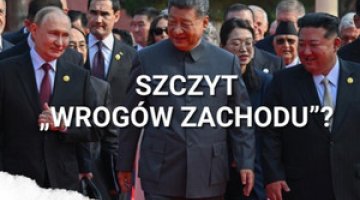Stopping Vietnam from making a U-turn. Xi Jinping’s visit to Hanoi
Xi Jinping’s trip to Hanoi was intended to convince Vietnam to withdraw from, or at least delay, taking two foreign policy steps that would be unfavourable to China: a strategic rapprochement with the US and a deal with Manila on the South China Sea. For its part, China may offer economic cooperation to Vietnam, but it does not seem able to compromise on its key strategic issues: territorial disputes and the hydrological policy concerning the Mekong River. This leads Beijing to continue its military pressure on Hanoi, while Vietnam wants to avoid playing the role of a ‘frontline state’ in the Sino-American rivalry.
Xi Jinping paid a two-day visit to Hanoi on 12 December as a representative of both his country and the Communist Party of China. Relations between China and Vietnam are developing simultaneously on two levels: on the inter-party level as contacts between the Communist Party of China (CPC) and the Communist Party of Vietnam (CPV); and on the inter-state level, with the former taking precedence. Given the dual nature of the visit, Xi Jinping in his capacity as Secretary General of the CPC met Nguyen Phu Trong, his counterpart from the CPV, on the first day of the visit. On the second day, as the Chairman of the People’s Republic of China, he met the rest of Vietnam’s senior officials, including President Vo Van Thuong, Prime Minister Pham Minh Chinh and Chairman of the National Assembly Vuong Dinh Hue. Although these two Leninist states have similar political systems and share the same ideology, a mixture of Marxism and nationalism typical of national liberation movements, relations between the People’s Republic of China (PRC) and the Socialist Republic of Vietnam (SRV) are determined by conflicting national interests.
Xi Jinping’s trip to Vietnam, his first in six years, took place just three months after US President Joe Biden visited Hanoi in September, followed by a Vietnamese government delegation’s return visit to Washington. According to media reports, the Chinese leader had originally been considering visiting Hanoi three days before Biden, but prolonged negotiations with Vietnam regarding strengthening mutual relations got in the way. China reportedly insisted on the ‘shared destiny’ formula, referring to a number of Chinese international initiatives. Vietnam opposed this –largely for tactical reasons, in order to postpone the visit – and eventually agreed to the change. Beijing was making the push because Vietnam-US relations had been lifted to a higher level, to ‘comprehensive strategic partnership’ status, and a similar change had taken place in Vietnam’s relations with Japan. Furthermore, there are also plans to change the status of Hanoi’s relations with Australia.
The fact that the two rivals have both been making efforts to build closer relations is proof of Vietnam’s growing strategic and economic importance, hence China’s dissatisfaction with the strengthening of ties between Vietnam and the United States & its allies. The formal change of nomenclature in relations between Vietnam and China will not alter the political reality in which, despite their short- and medium-term joint economic projects, both sides are still divided by territorial disputes and long-term strategic interests. Both the special celebration of Xi Jinping’s visit by the hosts and the narrative of Chinese propaganda about the ‘common future’ of the two countries are nothing more than attempts to cover up the growing disagreements between the two countries.
During the visit, 36 documents on bilateral cooperation were signed. These cover many areas, including quarantine and inspection, development cooperation, the digital economy, green development, transport, regional cooperation, defence, law enforcement & security cooperation and maritime cooperation. However, 19 of them are just memorandums of understanding or non-binding agreements that only mark the beginning of negotiations, and three concern relations between the ‘fraternal’ Communist parties. The rest are as follows:
- an agreement on deepening cooperation between the ministries of foreign affairs,
- an agreement on the extradition of prisoners and people convicted of crimes,
- an agreement on preventing and combating crime,
- an agreement on the joint construction of a bridge across the Red River to connect the Bat Xat frontier area in Vietnam’s Lao Cai province and the Basa frontier area in China’s Yunnan province, and the accompanying protocol on simplifying migration procedures for personnel, means of transport, construction equipment and construction materials to that end at the Lao Cai-Hekou international border crossing,
- an agreement on conducting joint search and rescue operations at sea,
- a judicial cooperation programme for 2024–2025,
- a cooperation agreement between the Committee for Ethnic Minorities of Vietnam and the National Ethnic Affairs Commission of China,
- a protocol on quarantine requirements for watermelons exported from Vietnam to China, and
- a cooperation agreement between Voice of Vietnam Radio and the China Media Group (CMG).
Alongside the construction of the bridge on the Red River, another project which is important for economic cooperation is the action plan for 2023–6 implementing the memorandum of understanding between the Ministry of Industry & Trade of Vietnam and the government of China’s Yunnan province regarding closer economic and trade cooperation. The only agreement which genuinely addresses the growing tensions between the two countries is the one concerning the establishment of a hotline for handling information on unexpected incidents arising from fishing activities at sea. At every step the Chinese side has also emphasised the importance of the Belt and Road Initiative in economic relations. However, so far the only project in Vietnam to have been granted loans as part of this initiative is the Hanoi Metro. Even in this case, the Vietnamese side has avoided openly linking investments to the Belt and Road Initiative due to the strong anti-Chinese sentiments predominant among the Vietnamese public. Therefore, the signing of the cooperation plan to promote connectivity between the bilateral China-Vietnam ‘Two Corridors, One Belt’ agreement and China’s global Belt & Road Initiative represents a clear concession by Hanoi.
The relationship’s economic aspect
Leaks to the media suggest that the project of expanding railway connections between China and northern Vietnam was also discussed. Vietnam would like to increase exports, especially of agricultural products, to China. In turn, China wants to establish stronger economic ties with Vietnam by integrating the northern regions of Vietnam with supply chains in southern China. Bringing the project under the umbrella of the Belt & Road Initiative is also important to Xi Jinping for propaganda reasons. Vietnam has benefitted economically from the strain in US-China relations because this has led to many companies (including Chinese) to move all or part of their production to Vietnam, a process which has only gained momentum during this year. In this light, increasing the number of connections will not have such an obviously positive impact: on the one hand, imports of Chinese components that are assembled in Vietnam would be streamlined and Vietnam would benefit in the short-term; but on the other, the country’s economic dependence on China would grow. We may therefore conclude that despite the Vietnamese side’s formal enthusiasm, at the practical level it will proceed much more cautiously.
The situation in the area of telecommunications cooperation is similar. Beijing is making efforts to include Vietnam in the Digital Silk Road and increase the participation of Chinese companies in electronic communications infrastructure, building 5G networks and laying undersea fibre-optic cables. From Hanoi’s point of view, this would not only pose a threat to national security, but would also put Vietnam at risk of being excluded from Western digital ‘life’, which will hamper the integration of its economy with the West. Reportedly, bilateral cooperation in the area of extraction and refining of rare-earth elements and other minerals that are essential for modern industry was also on the talks’ agenda. China is especially interested in minerals used in the production of electric car batteries as well as solar panels and other renewable energy sources. Beijing’s goal is to dominate the global supply chain in this sector, and Vietnam has some of the largest known deposits of rare-earth elements.
China-Vietnam disputes
However, the relations between Vietnam and China are mainly determined by territorial disputes and regional rivalry. China claims most of the South China Sea (see Nine dashes. Beijing's territorial claims in the South China Sea), including areas covered by Vietnam’s exclusive economic zone (EEZ), which can be demarcated under the UN Convention on the Law of the Sea (UNCLOS). In 1974, China forcibly occupied the Paracel Islands, which had been under the administration of the Republic of Vietnam before that country’s unification. It also occupies several land areas in the South China Sea which are claimed by Vietnam. Although the last fighting between the two countries took place in 1988, the Chinese coast guard regularly harasses Vietnamese fishermen, including in Vietnam’s EEZ. In 2017, the Chinese government threatened to launch a military operation in order to force Vietnam to withdraw a mining license held by the Spanish company Repsol, which was engaged in searching for natural gas and oil deposits under the seabed. Since then, Hanoi has been unable to find an investor for mineral exploitation projects in its EEZ. Beijing has deployed air defence systems and missile batteries on artificially built islands; these weapons can cover most of Vietnam’s territory. The dispatch just a few days before Xi Jinping’s trip to Hanoi of a group of ships to the Ream naval base in Cambodia (less than 60 nautical miles away from Vietnam’s borders), where China is modernising installations and piers, has thus been interpreted as an element of increasing military pressure.
China’s territorial disputes with Vietnam (and other coastal states) in the South China Sea seem impossible to resolve, because they affect not only the latter’s vital economic interests but also its territorial sovereignty. Beijing would have to recognise Vietnam’s EEZ, but this would undermine China’s claims to the remaining disputed territories in the South China Sea and jeopardise the legitimacy of the Chinese Communists at home: nationalism is an important element of the national political narrative for both China and Vietnam. For this reason, the objectives of Xi Jinping’s visit also included preventing the conclusion of agreements demarcating the EEZs of Vietnam and the Philippines, which is one of the foreign policy goals of the Philippines’ president, Ferdinand Marcos Jr. If the territorial dispute between Vietnam and China, which have the largest mutually exclusive claims in the region, is resolved on the grounds of the UNCLOS, the UN convention would probably be recognised as the bedrock for zone delimitation by the remaining parties to the dispute – apart from Beijing. If this is the case, China would have to confront a united front made up of all the other coastal nations.
Since 1993, China has built six dams in the Upper Mekong Basin, thus basically giving it control of hydrological policy throughout the entire length of the river. Changes in water flows, on which it decides unilaterally, affect the entire economies of the countries in the middle and lower reaches of the river: Myanmar, Laos, Thailand, Cambodia and Vietnam. In general, China’s moves are currently dictated by its electricity production needs rather than any concern about maintaining a balanced hydrological policy along the length of the river, which would require reducing flows in the rainy season and increasing them in the dry season. China’s actions particularly affect Vietnam, because the changes in water flows are more intense than would have resulted from the natural seasonal cycle; this increases the salinity of the Mekong Delta and adversely affects agricultural production in a region that is key to national agriculture, jeopardising Vietnam’s food self-sufficiency. There are also growing concerns that Beijing may use the flow controls to increase political pressure in the future. In addition, there are plans to redirect some water from the upper reaches of the river to the north-eastern regions of China.
Prospects
The escalating rivalry between China & the US is a source of both increased opportunities and increased threats for Vietnam. This country was isolated on the international stage after the collapse of the USSR, and without Moscow’s support, it has lost influence in Laos & Cambodia to China, and must withstand growing Chinese military and economic pressure. Vietnam has been receiving strong political support and tangible military assistance in various forms from the United States, Japan, India and Australia. Since the normalisation of diplomatic relations in 1995, each successive US president has visited Hanoi at least once, emphasising the importance of Vietnam to Washington’s position in East Asia. The economy also benefits from this, as American and international corporations make more and more new investments in Vietnam.
At the same time, Vietnamese leaders fear that their country will become a frontline state in both political and military terms. This may pose an existential threat to Vietnam, which fought a border war with China in 1979. It needs to be cautious while building closer ties with the US, not only for fear of Beijing’s reaction, but also due to fluctuations in Washington’s foreign policy resulting from internal polarisation. Hanoi experienced this in 2017, when President Donald Trump refused to support Vietnam after it came under pressure from China to revoke Repsol’s licence. For these reasons, Vietnamese Communists do not want to openly antagonise the ‘fraternal’ Communist Party of China, and will continue the policy of rapprochement with the West; at the same time, however, they will try to appease Beijing by making certain economic or prestige concessions. China, on the other hand, will try to delay Vietnam’s strategic U-turn towards the West.





